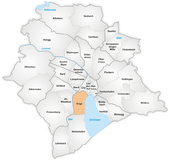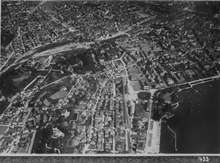Enge (Zürich)
Enge is a quarter in District 2 of Zürich, Switzerland.


History
Enge was incorporated into Zürich in 1893, along with 11 other formerly independent municipalities.[1] In 2011, the population was 8,597.[2] Enge, which is only 2.4 km2, is the smallest neighbourhood in district 2.
Transportation
Zürich Enge railway station is a stop of Zürich S-Bahn on the lines S2, S8, S21 and S24.
Cultural heritage
Enge is located in prehistoric swampland on small islands around Sechseläutenplatz and peninsulas in Zürich. It is situated between the Limmat and Lake Zurich. Prehistoric pile dwellings around Lake Zurich were set on piles in order to protect against the occasional flooding of the rivers Linth and Jona. Zürich–Enge Alpenquai, a locality of the municipality of Zürich, is located on the shore of Lake Zurich in Enge. It was bordered by the settlements at Kleiner Hafner and Grosser Hafner on a peninsula island in the effluence of the Limmat, within an area of about 0.2 square kilometres (49.42 acres) in Zürich. It is one of 56 Swiss sites of the UNESCO World Heritage Site Prehistoric pile dwellings around the Alps,[3][4] the settlement is also listed in the Swiss inventory of cultural property of national and regional significance as a Class object, as well as the Arboretum including the Voliere Zürich,[5] as part of the so-called Quaianlagen.[6]
The Synagoge Zürich Löwenstrasse is also listed as a Class B object of regional importance,[7] The library of the Israelitische Cultusgemeinde Zürich (ICZ) in Zürich-Enge at the Arboretum Zürich is listed as a Class A object of national importance.[8]
Notable people
- Lydia Welti-Escher (1858–1891), patron of the arts and founder of the Gottfried Keller Stiftung.
- Gottfried Keller (1819–1890), Swiss poet.
References
- "Quartier Enge Geschichte". www.enge.ch. Retrieved 2016-01-02.
- "Quartier Enge - Statistik". www.enge.ch. Retrieved 2016-01-02.
- "Prehistoric Pile Dwellings in Switzerland". Swiss Coordination Group UNESCO Palafittes (palafittes.org). Archived from the original on 2014-10-07. Retrieved 2014-12-10.
- "World Heritage". palafittes.org. Archived from the original on 2014-12-09. Retrieved 2014-12-10.
- "Voliere Zürich – Vogelpflegestation" (in German). Voliere Zürich. Retrieved 2014-12-28.
- "A-Objekte KGS-Inventar". Schweizerische Eidgenossenschaft, Amt für Bevölkerungsschutz. 2009. Archived from the original on 2010-06-28. Retrieved 2014-12-10.
- "B-Objekte KGS-Inventar" (PDF). Schweizerische Eidgenossenschaft, Amt für Bevölkerungsschutz. 2015-02-18. Archived from the original (PDF) on 2015-10-01. Retrieved 2015-12-17.
- "A-Objekte KGS-Inventar" (PDF). Schweizerische Eidgenossenschaft, Amt für Bevölkerungsschutz. 2015-01-01. Archived from the original (PDF) on 2015-10-01. Retrieved 2015-12-17.
| Wikimedia Commons has media related to Enge. |